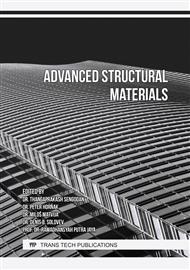[1]
Information on https://materials-today.com/kevlar-uses-properties-and-processing/
Google Scholar
[2]
Information on https://www.science.org.au/curious/technology-future/composite-materials
Google Scholar
[3]
Sauer, Max James. Evaluation of the Mechanical Properties of 3D printed Carbon Fiber Composites, South Dakota, 2018. https://proquest.com.
Google Scholar
[4]
Saeed, Khalid and Alistair McIlhagger, Characterization of Continuous Carbon Fibre Reinforced 3D Printed Polymer Composites with Varying Fibre Volume Fractions, Compos. Struc., 2021.
DOI: 10.1016/j.compstruct.2021.115033
Google Scholar
[5]
Dong, Guoying and Yunlong Tang. Mechanical properties of Continuous Kevlar Fiber Reinforced Composites fabricated by Fused Deposition Modeling Process in: L. Wang (Eds.), Procedia Manufacturing, E-Publishing Inc., USA, 2018, pp.774-781.
DOI: 10.1016/j.promfg.2018.07.090
Google Scholar
[6]
Pertuz, Alberto, D., Sergio Díaz-Cardona, Static and Fatigue Behavior of Continuous Fiber Reinforced Thermoplastic Composites Manufactured by Fused Deposition Modeling Technique, Int. J. Fatigue. 130 (2020).
DOI: 10.1016/j.ijfatigue.2019.105275
Google Scholar
[7]
Sanei, Seyed HR, Andrew Arndt, and Randall Doles, Open hole tensile testing of 3D printed Continuous Carbon Fiber Reinforced Composites, J. Compos. Mater. 0 (2020) 1-9.
DOI: 10.1177/0021998320902510
Google Scholar
[8]
Prajapati, Ashish R and Harshit K. Dave, Effect of Fiber Reinforcement on the Open Hole Tensile Strength of 3D Printed Composites in: A. Xavier, P. Jeyapandirajan (Eds.), Materials Today Proceedings, E-Publishing Inc., 2021, pp.8629-8633
DOI: 10.1016/j.matpr.2021.03.597
Google Scholar
[9]
P. Rodriguez, P. Zapico and P. E. Robel, Evaluation of mechanical properties of FDM Components Reinforced with Fiber J. Mater. Sci. Eng. (2021) 1193.
Google Scholar
[10]
Oztan, Cagri, Ryan Karkkainen and Mauro Fittipaldi, Microstructure and mechanical properties of three dimensional-printed continuous fiber composite J. Compos. Mater. 0 (2019) 1-9.
DOI: 10.1177/0021998318781938
Google Scholar
[11]
Chacón, J. M. and M. A. Caminero, Additive Manufacturing of Continuous Fibre Reinforced Thermoplastic Composites using Fused Deposition Modeling Effect of Process Parameters on Mechanical Properties, Composites science and technology, Wei Chu, 2019.
DOI: 10.1016/j.compscitech.2019.107688
Google Scholar
[12]
Agarwal, Kuldeep, and Suresh K. Mechanical properties of Fiber Reinforced Polymer Composites. A Comparative Study of Conventional and Additive Manufacturing Methods, J. Compos. Mater. 0 (2018) 1-9.
DOI: 10.1177/0021998318762297
Google Scholar
[13]
Mausam, Kuwar. Comparative Experimental Investigation of Properties of Kevlar Composites and E-glass-Reinforced Kevlar Fiber Hybrid Composites Suitable for Making Component of Wing Box in Aerospace Industry in: G. Manik, S. Kalia (Eds.), Advances in Mechanical Engineering, E-Publishers Inc., Singapore, 2021, pp.291-299.
DOI: 10.1007/978-981-16-0942-8_27
Google Scholar
[14]
Ganesamoorthy, R. Meenakshi, Studies on Mechanical Properties of Kevlar, Napier/Glass Fibers Reinforced with Polymer Matrix Hybrid Composite, J. Adv. Mater. Sci. Eng.2021.
DOI: 10.1155/2021/6907631
Google Scholar
[15]
Natarajan, Elango, Lídio Inácio Freitas, Experimental and Numerical Analysis on suitability of S-Glass Carbon Reinforced Polymer Composites for Submarine hull, Defence Technology,2022.
DOI: 10.1016/j.dt.2022.06.003
Google Scholar
[16]
Krzikalla, David and Jakub Měsíček, On Flexural Properties of Additive Manufactured Composites: Experimental and Numerical Study, Composites Science and Technology, Tsu-Wei-Cheu, 2022.
DOI: 10.1016/j.compscitech.2021.109182
Google Scholar
[17]
Giarmas, Evangelos and Konstantinos Tsongas, Mechanical and FEA-Assisted Characterization of 3D Printed Continuous Glass Fiber Reinforced Nylon Cellular Structures, J. Compos. Sci. 313, 2021.
DOI: 10.3390/jcs5120313
Google Scholar
[18]
Lawrence, Bradley and D. Michael. Evaluation of the Mechanical Properties and Performance Cost of Additively Manufactured Continuous Glass and Carbon Fiber Composites. Int. J. Adv. Manuf. Technol. 120 (2022) 1135-1147.
DOI: 10.1007/s00170-022-08879-w
Google Scholar
[19]
Wang, Kui, Shixian Li, Flexure Behavior of ABS-Composites containing Carbon and Kevlar Fibers by Material Extrusion 3D Printing, Polymers, Eleventh Ed, 2019.
DOI: 10.3390/polym11111878
Google Scholar
[20]
Dou, Hao, Yunyong Cheng, Effect of Process Parameters on Tensile Mechanical Properties of 3D Printed Continuous Carbon Fiber Reinforced PLA Composites, Materials, Thirteenth Ed, 2020.
DOI: 10.3390/ma13173850
Google Scholar
[21]
Kasmi, Samir, Geoffrey Ginoux and Samir Allaoui, Investigation of 3D Printing Strategy on the Mechanical Performance of Co-extruded Continuous Carbon Fiber Reinforced PETG, J. Appl. Polym. 2021.
DOI: 10.1002/app.51009
Google Scholar
[22]
Information on https://markforged.com/3d-printers
Google Scholar
[23]
Information on https://hyderabadlabs.net/destructive%20testing.html
Google Scholar
[24]
Information on https://www.tsgc.utexas.edu/tadp/1996/reports/tech/material2.html
Google Scholar
[25]
Information on https://www.matweb.com>search>datasheet
Google Scholar
[26]
Information on https://material-properties.org/carbon-fiber-application-price/
Google Scholar
[27]
Krucinska, Izabella, and Tomasz Stypka. Direct Measurement of the Axial Poisson's Ratio of Single Carbon Fibres in: L. Wang (Eds.), Composites Science and Technology, E-Inc Publishers, 1991, pp.1-12.
DOI: 10.1016/0266-3538(91)90049-U
Google Scholar



